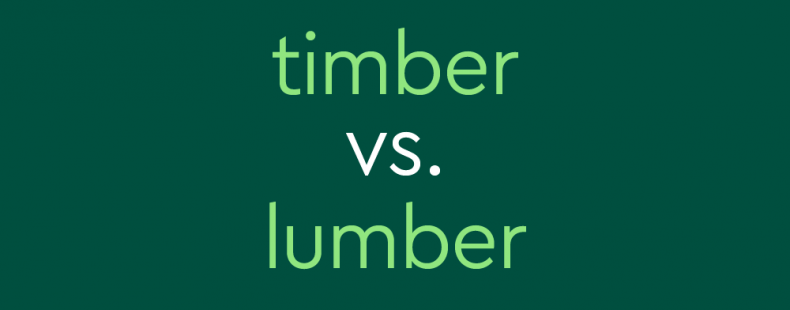Timber and lumber sound a lot alike, and they both generally refer to the same thing: wood. But when exactly is wood considered timber and when is it considered lumber?
Join us as we split the differences between the meanings of timber and lumber, cover the ways they overlap, and explain why timberjack (yes, it’s a word) might be more accurate than lumberjack. Hint: there’s a reason why we yell “Timberrrrrr!” when cutting down trees.
⚡️Quick summary
In the US and Canada, timber is typically used to collectively refer to trees—or the wood of such trees—that have yet to be cut or processed, while lumber typically refers to wood that has been processed as a building material (boards and planks). Elsewhere, especially in the UK, the word timber is used to mean the same thing as lumber.
What is timber?
Timber most commonly refers to the wood of trees that can or will be used for building material. The word can refer to living, standing trees themselves or to trees that have been cut down but not yet processed (meaning they have not yet been milled or cut into planks).
More generally, timber can refer collectively to living trees or to a wooded area, regardless of whether the trees will be harvested for wood. When such land is used for logging, it’s sometimes called timberland.
In some places, such as the UK, the word timber can be used in these ways, but it’s also used to mean the same thing as lumber.
The trees are especially remarkable during fall. Read about the history of the season’s names.
What is lumber?
Lumber typically refers collectively to wood that’s been processed for use as a building material—wood that has been milled and cut into boards or planks. This cutting happens in a lumbermill, and the finished product is sold at a lumberyard.
Lumber and these other related words are primarily used in the US and Canada. In the UK, prepared wood for building is called timber (and it’s sold at what’s known as a timberyard).
Where do timber and lumber come from?
Etymologically, it’s just a coincidence that timber and lumber both end with -mber. Timber comes from an Old English word that was originally used to mean “house, building material, wood, trees.” The noun lumber comes from the verb lumber, meaning “to move clumsily or awkwardly,” such as due to carrying something heavy (like planks of wood).
What’s the difference between timber vs. lumber?
In the US and Canada, timber workers have historically been called lumberjacks even though their job is to harvest what’s known in these places as timber.
In these places, timber refers to standing trees or to the wood from these trees before it’s been processed into lumber—building materials. The cutting of the timber into lumber is done at the lumbermill (or sawmill) and you buy the boards and planks at a lumberyard.
A good way to remember that timber refers to trees or wood before they’re processed into lumber is to remember that lumberjacks in the US and Canada are known for yelling “Timber!” when a tree is about to fall. (Maybe we should call them timberjacks instead.)
Remember, this distinction between timber and lumber is mainly used in the US and Canada. Elsewhere, especially the UK, the word timber is used to refer to the processed wood as a building material.
Examples of timber and lumber used in a sentence
To help you understand the difference, take a look at these examples of timber and lumber in a sentence.
- The processing of timber into lumber requires heavy machinery.
- The timber industry has been the target of criticism for unsustainable logging practices.
- The lumberjack yelled “Timber!” as the tree fell.
- A large load of lumber, mostly two-by-fours, was delivered to build the house.
- Fortunately, the wildfire didn’t reach the vast stands of timber on the other side of the mountain.














